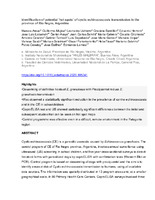Please use this identifier to cite or link to this item:
http://sgc.anlis.gob.ar/handle/123456789/1516| Title: | Identification of potential 'hot spots' of cystic echinococcosis transmission in the province of Río Negro, Argentina | Authors: | Arezo, Marcos Mujica, Guillermo Uchiumi, Leonardo Santillan, Graciela Herrero, Eduardo Labanchi, Jose Luis Araya, Daniel Salvitti, Juan Carlos Cabrera, Marta Grizmado, Claudia Calabro, Arnoldo Talmon, Gabriel Sepulveda, Luis Galvan, Jose Maria Volpe, Marcela Bastin, Vanesa Seleiman, Marcos Panomarenko, Oscar Tissot, Hebe Sobrino, Mariano Crowley, Pablo Daffner, Jose Larrieu, Edmundo |
Keywords: | Equinococosis;Echinococcus granulosus;Equinococosis;Argentina;Río Negro | Issue Date: | 15-Jan-2020 | Journal: | Acta tropica | Abstract: | Cystic echinococcosis (CE) is a parasitic zoonosis caused by Echinococcus granulosus. The control program of CE of Rio Negro province, Argentina, involves annual surveillance using ultrasound (US) screening in school children, and five-year cross-sectional surveys to detect livestock farms with parasitized dogs by coproELISA with confirmation tests (Western Blot or PCR). Control program is based on deworming of dogs with praziquantel and the aim is to identify areas at risk of Cystic echinococcosis transmission to humans, using all available data sources. The information was spatially distributed in 13 program areas and, at a smaller geographical scale, in 80 Primary Health Care Centers. CoproELISA surveys involved three randomized sampling periods (2003-05, 2009-10, 2017-18), with 1790 canine fecal samples. The US surveys were conducted in 2003-08, 2009-16 and 2017-18 in 34515 children. Heat maps were created at the smallest geographic scale with QGIS 3.4.6. For the consecutive sampling periods, prevalence of positive canine fecal samples from livestock farms were 14.7, 12.1 and 7.8%, respectively, and children prevalence was 0.4, 0.2 and 0.1%, respectively. The study has been developed on a scale according to which the temporal-spatial distribution of CE allows to adjust control strategies in those areas of potential transmission of the zoonosis to humans. |
Description: | Fil: Santillán, G. ANLIS Dr.C.G.Malbrán. Instituto Nacional de Enfermedades Infecciosas; Argentina. |
URI: | http://sgc.anlis.gob.ar/handle/123456789/1516 https://www.sciencedirect.com/science/article/pii/S0001706X19312999 |
DOI: | 10.1016/j.actatropica.2020.105341 |
| Appears in Collections: | Publicaciones INEI |
Files in This Item:
| File | Description | Size | Format | |
|---|---|---|---|---|
| j.actatropica.2020.105341.pdf | Artículo en inglés | 362.91 kB | Adobe PDF |  View/Open |
Page view(s)
779
checked on Jan 5, 2026
Download(s)
32
checked on Jan 5, 2026
Google ScholarTM
Check
Altmetric
Altmetric
Items in DSpace are protected by copyright, with all rights reserved, unless otherwise indicated.

